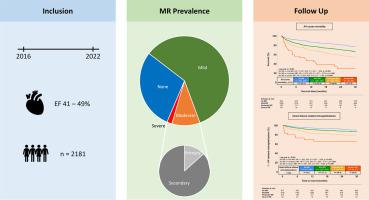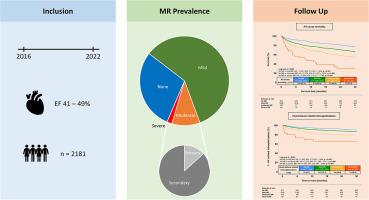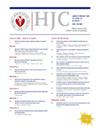Prognostic value of mitral valve regurgitation in patients with heart failure with mildly reduced ejection fraction
IF 3
3区 医学
Q2 CARDIAC & CARDIOVASCULAR SYSTEMS
引用次数: 0
Abstract
Background
Although mitral valve regurgitation (MR) is a common valvular heart disease in patients with heart failure (HF), there is a paucity of data on the characterization and outcomes of patients with HF with mildly reduced ejection fraction (HFmrEF) and concomitant MR.
Methods
From 2016 to 2022, consecutive patients hospitalized with HFmrEF (i.e., left ventricular ejection fraction from 41% to 49% and signs and/or symptoms of HF) were retrospectively included at one institution. Patients with MR were compared with patients without MR. Further risk stratification was performed according to MR severity and etiology (i.e., primary vs. secondary MR). The primary end point was all-cause mortality at 30 months (median follow-up), and the key secondary end point was hospitalization for worsening HF.
Results
Of 2181 patients hospitalized with HFmrEF, 59% presented with mild, 10% with moderate, and 2% with severe MR. MR was associated with increased all-cause mortality at 30 months (HR = 1.756; 95% CI 1.458–2.114; p = 0.001), with higher risk in more advanced stages. Furthermore, MR patients had higher risk of HF-related re-hospitalization at 30 months (HR = 1.560; 95% CI 1.172–2.076; p = 0.002). Even after multivariable adjustment, mild, moderate, and severe MR were still associated with all-cause mortality. Finally, the risk of all-cause mortality was lower in patients with secondary MR compared with patients with primary MR (HR = 0.592; 95% CI 0.366–0.956; p = 0.032).
Conclusion
MR is common in HFmrEF and independently associated with higher risk of all-cause mortality and HF hospitalization.


射血分数轻度降低型心力衰竭患者二尖瓣反流的预后价值
背景:尽管二尖瓣反流(MR)是心力衰竭(HF)患者常见的瓣膜性心脏病,但有关HFmrEF和合并MR患者的特征和预后的数据却很少:方法:从2016年至2022年,回顾性纳入了一家机构连续住院的HFmrEF(即左室射血分数41%-49%,且有HF体征和/或症状)患者。将患有 MR 的患者与未患有 MR 的患者进行比较,并根据 MR 的严重程度和病因(即原发性 MR 与继发性 MR)进一步进行风险分层。主要终点是随访30个月(中位数)时的全因死亡率,关键的次要终点是因心房颤动恶化而住院:在住院的 2,181 名 HFmrEF 患者中,59% 患有轻度 MR,10% 患有中度 MR,2% 患有重度 MR。MR 与 30 个月的全因死亡率增加有关(HR = 1.756;95% CI 1.458 - 2.114;P = 0.001),晚期患者的风险更高。此外,MR 患者在 30 个月时与心房颤动相关的再住院风险更高(HR = 1.560;95% CI 1.172 - 2.076;P = 0.002)。即使经过多变量调整,轻度、中度和重度 MR 仍与全因死亡率相关。最后,与原发性MR患者相比,继发性MR患者的全因死亡风险较低(HR = 0.592; 95% CI 0.366 - 0.956; p = 0.032):结论:MR在HFmrEF中很常见,与较高的全因死亡率和HF住院风险独立相关。
本文章由计算机程序翻译,如有差异,请以英文原文为准。
求助全文
约1分钟内获得全文
求助全文
来源期刊

Hellenic Journal of Cardiology
CARDIAC & CARDIOVASCULAR SYSTEMS-
CiteScore
4.90
自引率
7.30%
发文量
86
审稿时长
56 days
期刊介绍:
The Hellenic Journal of Cardiology (International Edition, ISSN 1109-9666) is the official journal of the Hellenic Society of Cardiology and aims to publish high-quality articles on all aspects of cardiovascular medicine. A primary goal is to publish in each issue a number of original articles related to clinical and basic research. Many of these will be accompanied by invited editorial comments.
Hot topics, such as molecular cardiology, and innovative cardiac imaging and electrophysiological mapping techniques, will appear frequently in the journal in the form of invited expert articles or special reports. The Editorial Committee also attaches great importance to subjects related to continuing medical education, the implementation of guidelines and cost effectiveness in cardiology.
 求助内容:
求助内容: 应助结果提醒方式:
应助结果提醒方式:


